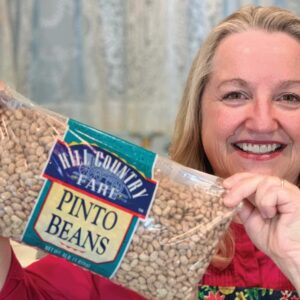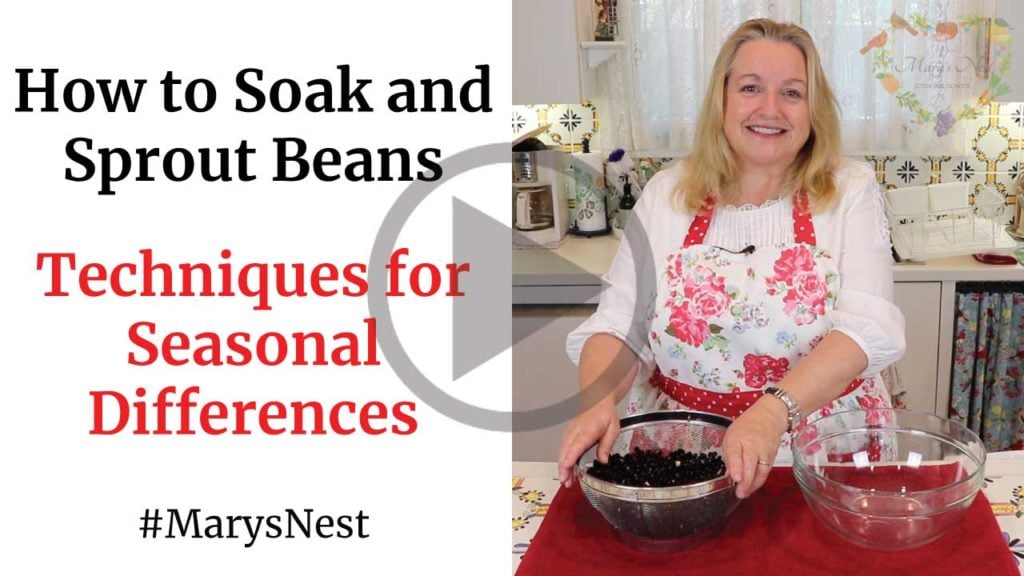Affiliates note: As an Amazon Associate I earn from qualifying purchases. My content may contain affiliate links to products and services. If you click through and make a purchase, I'll receive a small commission. It does not affect the price you pay.
How to Cook Dried Beans – The Right Way

Learn How to Cook Dried Beans the right way for maximum nutrition so that you can have these nutritious and convenient foods as a staple in your traditional foods pantry.
Why Soak Dried Beans?
When it comes to the process of cooking dried beans, focus on how to maximize extracting as much nutrition out of those humble beans as possible. And that’s why soaking dried beans is so important. And it’s not just about reducing their gaseous effects!
The Problem With Phytic Acid
Phytic acid is a compound found in many foods and specifically in grains and beans. You can learn more about their problematic effects in grains in my article and accompanying video where I show you how to soak and sprout grains.
But when it comes to beans, it’s important to soak them for an extended period of time—a minimum of 12 hours, but 48 hours is better—to activate a compound called phytase. And why activate phytase? Because phytase helps to deactivate some of the phytic acid.
We want to deactivate some of the phytic acid because it can make it difficult for us to absorb the nutrients in beans. Plus, phytic acid can also bind to certain minerals, like iron, in our bodies and strip them out of us. But the good news is that when we soak our beans, we deactivate some of that phytic acid and improve our ability to absorb and hold on to important nutrients.
But is Phytic Acid All Bad?
But don’t worry. We don’t need to obsess about phytic acid and deactivate every last bit in our food. Phytic acid has a bright side. It’s an antioxidant that scientists believe may play a roll in the prevention of certain diseases. So retaining some phytic acid in our food may actually be a good thing.
Plus, something worth noting, certain ethnic groups benefit from having phytic acid in their diet to remove some minerals from their bodies, especially if their genetics, for one reason or another, tends to hold on to too many nutrients.
For example, scientists have found that people of Irish ancestry have a trait of sometimes holding onto too much iron. And guess what? Phytic acid helps remove some of that iron. Because just like too little iron is not a good thing, too much iron is not a good thing either. To learn more about this fascinating topic, be sure to watch my video where I discuss the pros and cons of soaking certain foods.
Getting Back to the Dried Beans
Well, that was an earful about phytic acid, but now you see why you want to soak your beans. The good news is that dried beans are very inexpensive and take little actual “hands-on” time to prepare. The bulk of the time is downtime on our part while the beans soak. And once they are done soaking, the cooking time is considerably shortened up to as much as 30 minutes.
Seasoned Perfectly
When it comes to making your beans, not only tender but tasty, I share a clever tip on how to season them perfectly. This tip allows the beans to absorb lots of flavor without affecting the cooking time—or their texture (Hint: Don’t salt the water while cooking the beans! I share a much better approach.). So be sure to watch the video and learn How to Cook Dried Beans – The Right Way!
More Bean Recipes
Now that you’ve learned the best way to cook dried beans, you can venture further into the world of beans and learn the secret to how to sprout beans! And with my tips, it’s much easier than you think—and you’ll be successful every time! So even on those days when you think life is a “Hill of Beans,” at least yours will be sprouted! 😉
And be sure to check out this delicious Italian Chickpea and Pork Rib soup recipe where I share a tasty way for using soaked…and sprouted…chickpeas!
Stay in Touch with Mary’s Nest
- Subscribe to My YouTube Channel for Traditional Foods Videos (Free) - When you subscribe, be sure to click on the notification bell that will let you know each time I upload a new video.
- Subscribe to Mary’s Traditional Foods Newsletter (Free) - Get a free 36-page eBook for signing up: How to Stock Your Essential Traditional Foods Four-Corners Pantry.
- Join the Traditional Foods Kitchen Academy - For more detailed videos and exclusive members-only perks, join my YouTube membership community.
- Order The Modern Pioneer Cookbook - Get a hardcover book of Mary's nourishing recipes from a Traditional Foods Kitchen. This bestselling cookbook is published by Penguin Random House with their DK imprint.
- Order The Modern Pioneer Pantry - Get Mary's latest hardcover cookbook about preserving food and making delicious meals from your Four Corners Pantry. Mary's second cookbook is also published by Penguin Random House.
I look forward to having you join me in my Texas Hill Country Kitchen!
I’d like to receive more tips and recipes from Mary’s Nest.
How to Cook Dried Beans

Ingredients
- 2 cups Beans, dried
- 10 cups Water
- 1 tablespoon Fine ground sea salt, optional
Instructions
- Rinse beans well in a colander or strainer.
- Pick over beans to remove any that are discolored. Also, remove any small stones or pebbles.
- Put beans into a large pot.
- Add 10 cups of water to the pot.
- Soak beans for 12-48 hours. If soaking for 48 hours, change the water after 24 hours.
- After beans have soaked, rinse well, and return to pot with a fresh 10 cups of water.
- Bring the beans to a boil, then quickly reduce the heat to a medium simmer. (See "NOTES" below.)
- Simmer the beans until tender. This can take anywhere from 30 minutes to 2 hours, depending on the type of bean.
- Once the beans are tender, remove the pot from the heat. If desired with the beans still in their cooking water, add the salt to the cooking water with the beans and stir to dissolve the salt. Allow the beans to sit in the salted water for approximately 5 minutes.
- Drain the beans.
- Cooked beans may be added to any dish, or kept refrigerated for up to 3-4 days. Beans may also be frozen for 2-3 months.
Video
Notes
Shop for items used in this blog post or video
Favorite Bean Cooking Supplies
Recommended Reading
Amazon Shop and Shopping Guide
- Visit Mary’s Nest Amazon Shop
- Visit my Shopping Guide page
Get up to 15% off for stocking your Traditional Foods Pantry and equipping your Modern Pioneer Kitchen, including discounts from US Wellness Meats, Farmhouse Teas, Backwoods Home, Masontops, Cultures for Health, Survival Garden Seeds, Redmond Real Salt, Mother Earth News, and More!
Affiliates note: As an Amazon Associate I earn from qualifying purchases. My content may contain affiliate links to products and services. If you click through and make a purchase, I’ll receive a small commission. It does not affect the price you pay.
Disclaimer:I am not a medical doctor, a medical professional, a dietician, or a nutritionist. All content found on the MarysNest.com website, including text, images, videos, eBooks or eGuides, social media, or other formats, were created solely for informational purposes only. The content is not intended to be a substitute for professional medical advice, diagnosis, or treatment. Always seek the advice of your physician or other qualified healthcare provider with any questions you may have regarding a medical condition or proper nutritional advice. Never disregard professional medical advice or delay in seeking it because of something you have watched in a video or read on this website. Use caution when following the recipe in this video. The creator and publisher of this video and website will not be held responsible for any adverse effects that may arise from the use of this recipe and method or any other recipe and method on this website or corresponding video channel.



When soaking the beans should they be left covered at room temperature or refrigerated?
Hi Erna,
You can choose to soak your beans either way. After you cover them, you can leave them on your countertop or put them in your refrigerator.
Thanks for your comment and for having me join you as part of your traditional foods journey.
Love and God bless,
Mary
why do you say to use 10 cups of water? That seems like an awful lot of water
for just 2 cups of beans. I have my beans soaking so I am anxious to try your recipe.
Hi Patricia, Great question. The 10 cups of water is only if you want to soak your beans overnight. After you soak your beans in the 10 cups of water, you drain the water off. Why 10 cups? It’s not an exact science but 10 cups for soaking is standard for 2 cups of dry beans. It provides plenty of water to keep the beans submerged and plenty of water for the dry beans to absorb. Hope this helps. Love, Mary
I soaked beans for 24 hours and then cooked them, they made the best pot of beans I have ever made! Thanks for the great tips.
I am SO happy to hear this!! Love, Mary
Can not wait to try! So I have soaked a mix of dried beans for 2 days and made a bone broth from the left over Easter ham bone. I’m going to cook up the beans and then add them to a soup with carrots, celery, leeks, cabbage, and a few potatoes.
Mary – thank you for being an inspiration!
Thank you for another good instructional video/recipe!
It was good to hear a little balance as to phytic acid not always being bad. It is otherwise known as IP6 and can be helpful in certain circumstances, as you said.
Hi Laurel, Thanks so much for sharing this. Yes, I always like to look at both sides of ingredients of real food. Love, Mary
I find it confusing that when I read your blog you go into depth about soaking the beans, and yet when I copy the recipe, there is NO mention of any soaking of the beans.
So which set of instructions are best – the actual recipe or the blog?
Oh Erica!! Thank you so much for brining that to my attention. When I was typing up my instructions as I copied my written instructions, I completely skipped over my soaking notes. Yes, very confusing indeed!! Please forgive me. I think I have fixed it and updated it. Thank you so much for your patience. Love, Mary